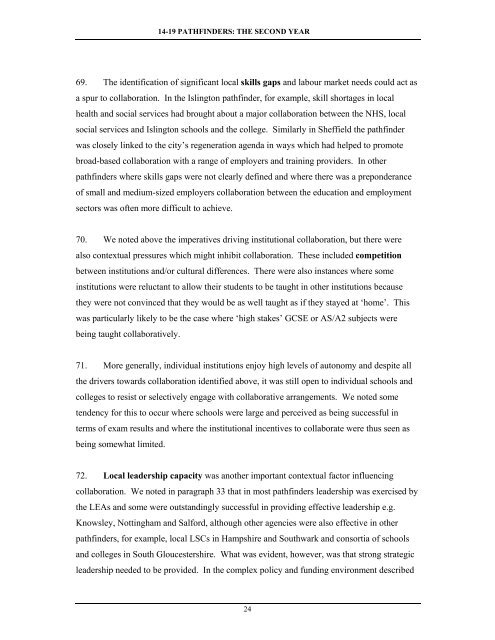Collaborative Approaches to 14-19 Provision - Communities and ...
Collaborative Approaches to 14-19 Provision - Communities and ...
Collaborative Approaches to 14-19 Provision - Communities and ...
- No tags were found...
Create successful ePaper yourself
Turn your PDF publications into a flip-book with our unique Google optimized e-Paper software.
<strong>14</strong>-<strong>19</strong> PATHFINDERS: THE SECOND YEAR69. The identification of significant local skills gaps <strong>and</strong> labour market needs could act asa spur <strong>to</strong> collaboration. In the Isling<strong>to</strong>n pathfinder, for example, skill shortages in localhealth <strong>and</strong> social services had brought about a major collaboration between the NHS, localsocial services <strong>and</strong> Isling<strong>to</strong>n schools <strong>and</strong> the college. Similarly in Sheffield the pathfinderwas closely linked <strong>to</strong> the city’s regeneration agenda in ways which had helped <strong>to</strong> promotebroad-based collaboration with a range of employers <strong>and</strong> training providers. In otherpathfinders where skills gaps were not clearly defined <strong>and</strong> where there was a preponderanceof small <strong>and</strong> medium-sized employers collaboration between the education <strong>and</strong> employmentsec<strong>to</strong>rs was often more difficult <strong>to</strong> achieve.70. We noted above the imperatives driving institutional collaboration, but there werealso contextual pressures which might inhibit collaboration. These included competitionbetween institutions <strong>and</strong>/or cultural differences. There were also instances where someinstitutions were reluctant <strong>to</strong> allow their students <strong>to</strong> be taught in other institutions becausethey were not convinced that they would be as well taught as if they stayed at ‘home’. Thiswas particularly likely <strong>to</strong> be the case where ‘high stakes’ GCSE or AS/A2 subjects werebeing taught collaboratively.71. More generally, individual institutions enjoy high levels of au<strong>to</strong>nomy <strong>and</strong> despite allthe drivers <strong>to</strong>wards collaboration identified above, it was still open <strong>to</strong> individual schools <strong>and</strong>colleges <strong>to</strong> resist or selectively engage with collaborative arrangements. We noted sometendency for this <strong>to</strong> occur where schools were large <strong>and</strong> perceived as being successful interms of exam results <strong>and</strong> where the institutional incentives <strong>to</strong> collaborate were thus seen asbeing somewhat limited.72. Local leadership capacity was another important contextual fac<strong>to</strong>r influencingcollaboration. We noted in paragraph 33 that in most pathfinders leadership was exercised bythe LEAs <strong>and</strong> some were outst<strong>and</strong>ingly successful in providing effective leadership e.g.Knowsley, Nottingham <strong>and</strong> Salford, although other agencies were also effective in otherpathfinders, for example, local LSCs in Hampshire <strong>and</strong> Southwark <strong>and</strong> consortia of schools<strong>and</strong> colleges in South Gloucestershire. What was evident, however, was that strong strategicleadership needed <strong>to</strong> be provided. In the complex policy <strong>and</strong> funding environment described24
















